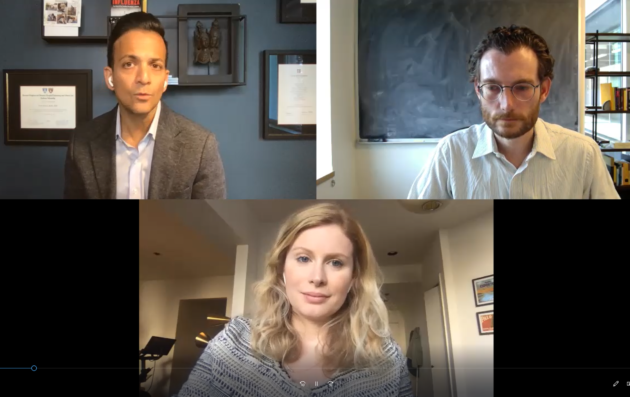Health experts weigh in on what we’ll have to do to get through a winter of COVID-19

You may want to put off that big holiday dinner. Don’t have your heart set on sending the kids back to school anytime soon. And if you plan to get on a plane, be sure to wear your mask.
Those are just a few of the nuggets of advice that critical-care physician Vin Gupta and computational biologist Trevor Bedford passed along for getting through this winter in the midst of the persistent coronavirus outbreak.
“We’re definitely not ’rounding the curve,’ ” Gupta said.
Gupta and Bedford delivered a data-rich status report on the pandemic today during a virtual GeekWire Summit session moderated by CNBC technology and health reporter Christina Farr.
The bottom line is that it’s still too early to let your guard down, despite what some politicians might claim.
“We’re seeing an increase in hospitalizations in 39 states — the highest hospitalization rates in places like Ohio and Michigan and Wisconsin that we’ve seen in the entire pandemic,” said Gupta, who’s affiliated with the University of Washington and also provides medical commentary for NBC News, CNN and The New York Times.
Bedford, a scientist at Seattle’s Fred Hutchinson Cancer Research Center who’s been tracking the novel coronavirus since the start of the U.S. outbreak, said there’s still a lot to learn about COVID-19 and how it spreads.
“It’s frustrating that we don’t know this like we should,” he said.

The statistics suggest that infections, hospitalizations and COVID-related deaths are heading upward again, due to relaxed restrictions as well as the fact that people are spending more time together indoors as the weather cools.
That trend applies nationwide — but Gupta noted that Washington state has gotten off better than many other parts of the country. The quick action that Amazon and Microsoft took to mandate working from home may well be one of the reasons for that, he said.
“You can make an argument that they made one of the greatest public health interventions, at least in this part of the country, by stipulating that before Gov. [Jay] Inslee did it two weeks later,” Gupta said.
Gupta counseled caution about trying to return to normal during the holidays.
“The thing that I know is not good is needless convening in large groups in poorly ventilated indoor settings,” he said. “So does that mean we have to lock down society? No. But does that mean you get to enjoy a cozy dinner right before Christmas in your favorite Seattle restaurant or your favorite San Francisco restaurant? Probably that means that’s not going to be on the [docket] for this holiday season.”
Previously: Experts foresee triumph and tragedy in COVID-19 vaccine quest
Gupta expressed strong reservations about having children go back to classrooms without proper safety measures. “It’s absolute insanity that we’re opening up schools and there is not an allotment for testing, at least weekly testing,” he said. (Most schools in the Seattle area plan to hold classes remotely until January at the earliest.)
In his view, flying on airplanes will be safer than sitting in a schoolroom, even though a cluster of COVID-19 cases was recently linked to in-flight transmission.
“Let’s say you were to wear some sort of face shield plus at least a three-ply surgical mask on a relatively short flight,” Gupta said. “Do I think that’s relatively safer than doing the same thing in a classroom, of which tens of millions of Americans are currently still in classrooms right now? Yeah, I actually think yes.”
Neither expert advised putting much faith in a strategy that relies on letting people get infected and build up immunity to the virus.
Statistics show that more than 225,000 Americans have already died due to COVID-19’s effects. “If we try to pursue an approach where herd immunity is the backbone of a pandemic strategy, anywhere from 800,000 to 1.2 million Americans may die,” said Gupta, citing figures from UW’s Institute of Health Metrics and Evaluation.
Bedford acknowledged that post-infection immunity can contribute to the fight against the pandemic. “I think immunity is actually starting to play a role in curbing spread, but it can’t be the thing that we rely on,” he said. “Immunity is helping us because we’re not able to control things entirely with societal mitigation measures.”
Both experts said they’d be keeping an eye on hospitalizations and the strain on hospital resources as key indicators for the course of the pandemic in the months ahead. Bedford is hopeful that the rollout of safe, effective vaccines will bring about a dramatic improvement in the situation next year.
“That will be the thing that really gets things back to some sort of normalcy,” he said, “and that will leave us with generally strengthened surveillance systems and public health, and an ability to deal with something like this in the future to a better degree.”
For up-to-date data about the pandemic, Gupta recommends checking in with COVID Act Now, the COVID Tracking Project and IHME’s Health Data website. Bedford posts updates to his Twitter account and maintains an archive of Twitter threads on the Bedford Lab website. This year’s virtual GeekWire Summit concludes on Thursday.
More from GeekWire:
Public health officials do a reality check on Elon Musk’s tweets about COVID-19 tests
Amid COVID-19 pandemic, experts lay out 10-point plan for a genomic revolution in public health
Coronavirus sleuths kick off campaign for digital tracing of COVID-19 contacts
GeekWire Summit recap: Final week highlights include T-Mobile CEO and COVID-19 data gurus

